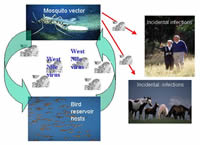|
|
 |
| Priority
Area 3: Applied Research on Diseases of Global Importance |
 |
|
Life
cycle of West Nile virus. West Nile encephalitis—which
is carried by birds in Asia, Africa, and Europe and
spread to humans by mosquito bite—has been recognized
as a U.S. health threat since 1999. CDC is working with
colleagues in Australia, the Czech Republic, France,
Israel, Romania, and Russia to study the epidemiology,
ecology, and pathogenesis of the West Nile virus and
find ways to prevent and control its transmission.
From
CDC's West Nile Web site. |
 |
|
|
CDC’s researchers have a dual role. They not only identify the microbes,
risk factors, and epidemiologic conditions that lead to outbreaks, but
also conduct applied research on ways to detect, prevent, and control
them. Maintaining a comprehensive diagnostic and investigative capacity
goes hand-in-hand with maintaining a broad-based research program on endemic
and epidemic diseases that includes studies in applied epidemiology, microbiology,
and behavioral and social science.
A research program on diseases that are uncommon in the United States
is a valuable resource, both for humanitarian reasons and because of the
dangers represented by some imported diseases. Had scientists begun to
study “slim disease”—now known as AIDS—when the syndrome
was described in central Africa in the late 1970s,12
the world health community might have learned much earlier how HIV is
acquired and what can be done to prevent its spread.
An in-depth knowledge of a wide range of infectious pathogens can also
facilitate the identification and characterization of new microbes that
emerge in the United States. One example concerns hantavirus pulmonary
syndrome (HPS), an often-fatal disease first identified in 1993 in the
Four Corners region of the United States. In 1993 hantavirus research
was a low priority in the United States, because hantavirus-associated
disease had never before been recognized in the Western Hemisphere. However,
a few laboratories supported by DoD had continued to collect information
on a hantaviral disease called Korean hemorrhagic fever or hemorrhagic
fever with renal syndrome (HFRS) that killed a significant number of United
Nations troops during the Korean Conflict. Because of these HFRS studies,
the CDC outbreak team in Four Corners was armed with sophisticated serologic
and molecular tools that allowed them to diagnose HPS in a short time.
Because it was known that the HFRS hantavirus is transmitted by rodents,
the team rapidly honed in on the animal reservoir of the HPS virus and
provided disease prevention guidelines to the people in the area.
Several fundamental precepts inform CDC’s infectious disease research
collaborations with other countries. First, the overriding purpose of
CDC’s research work overseas is to lead the way in demonstrating
how individuals and governments can best prevent and control disease.
Second, it is important for CDC to help strengthen international research
capacity by supporting extramural research at home and abroad, through
collaborations, cooperative agreements, and peer-reviewed grants. Third,
CDC’s research activities must be rooted in bioethical principles,
respecting the needs and rights of human research subjects. Fourth, CDC
must strive to engage new research partners, in addition to its traditional
partners at universities and schools of public health. Research collaborators
may include scientists from private companies, NGOs, and other U.S. agencies
(e.g., NIH, FDA, DoD, NASA, NOAA, and USDA).
Long-term, on-site research collaborations are especially important,
because it is often very difficult to study new and hazardous pathogens
while an outbreak is in progress. Long-term partnerships with in-country
research institutions may be mutually beneficial, facilitating collaborative
field research and clinical studies, providing opportunities for technology
transfer and training, and building international friendships and trust
within the scientific and public health communities. Previous
page | Next
page |
 |
 |
 |
|
 |


